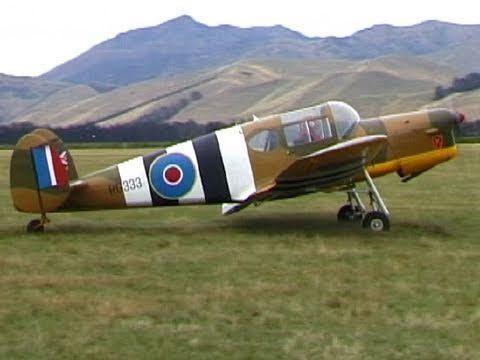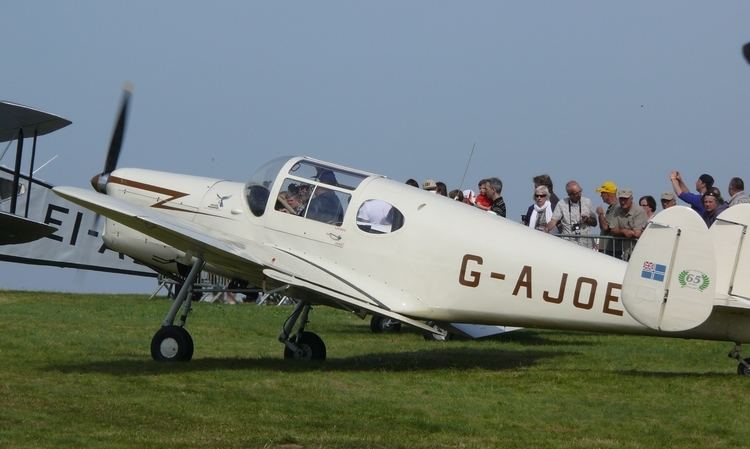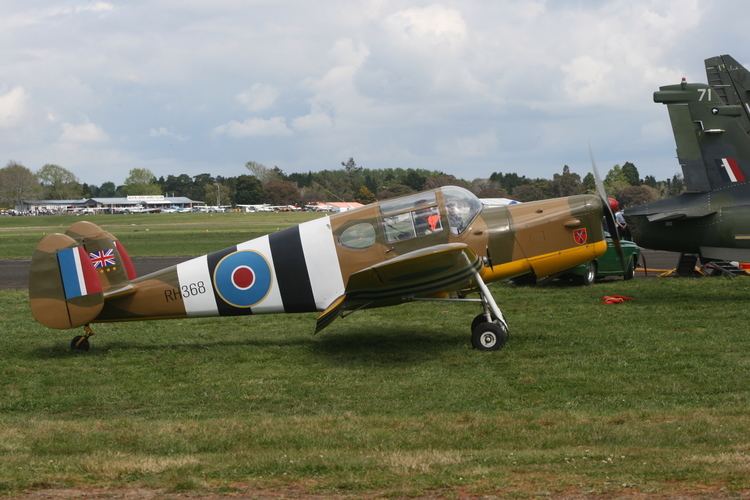Length 7.32 m Wingspan 11 m First flight September 12, 1942 | Top speed 217 km/h | |
 | ||
Ww2 miles messenger m 38 liaison aircraft
The Miles M.38 Messenger is a British four-seat liaison and private owner aircraft built by Miles Aircraft.
Contents
- Ww2 miles messenger m 38 liaison aircraft
- Miles messenger m 38 ww2 liaison aircraft
- Design and development
- Production and operations
- Variants
- Operators
- Specification Messenger 2A
- References
Miles messenger m 38 ww2 liaison aircraft
Design and development

The Messenger was designed to meet a British Army requirement for a robust, slow speed, low maintenance air observation post and liaison aircraft.
The aircraft designed was a cantilever low-wing monoplane with a fixed tailwheel, powered by the de Havilland Gipsy Major 1D inline engine.

Fitted with retractable auxiliary wing flaps enabling a wing loading of around 12.5 lb per square foot, the Messenger featured triple fins and rudders in order to maintain sufficient controllability down to the exceptionally low stalling speed of 25 mph.

The prototype was converted from a Miles M.28 Mercury and first flew at Woodley on 12 September 1942, some three months after an approach by army officers. When informally test flown by an Aerial Observation Post Squadron it was declared a success, meeting all the army's requirements, however the Ministry of Aircraft Production, having not been consulted, reprimanded George Miles for failing to seek the ministry's permission before rebuilding the aircraft and no orders for the Miles M.38 were placed for the aerial observation post role, AOP units using light, fixed-wing aircraft, notably various marks of Auster.

During the war George Miles continued to experiment with the prototype and suggested the aircraft (known as the M.38A) could be operated in the anti-submarine role using a small 60 foot (18.29 metre) deck aboard small merchant ships, landing using a simple arrester wire system. This was tried at Woodley using a simulated deck (with passengers simulating the weight of depth charges). Perhaps predictably, no official interest was expressed in this scheme.
However a year later a small order against Specification 17/43 was placed on behalf of the British Royal Air Force for the Messenger I to be employed in the VIP transport passenger transport role.
Wartime users of the type included Marshal of the Royal Air Force 1st Baron Tedder and Field Marshal Sir Bernard Montgomery. (The Messenger shown at the beginning of this article - in the guise of this aircraft - attended the 60th D-Day commemorations at the Imperial War Museum Duxford in 2004.)
Production and operations
During the war years of the 21 Messengers produced seventeen Messenger 1s survived, and when retired from RAF duties most were converted for civilian use as the Messenger 4A. They were flown by private pilots and business owners.
In 1944 the prototype was rebuilt as the M.48 Messenger 3 with fully retractable electrically-operated split trailing-edge flaps and a 155 h.p. Cirrus Major III engine. This model was not further developed as it did not provide any advantage over the other variants.
Post-war production centred on the Messenger 2A for the civilian market, aircraft being built at Newtownards in Northern Ireland and flown to Woodley for final fitting out. After 71 aircraft were built, production ceased in 1948; a single example was assembled, from existing parts, in 1950.
Several examples of the type were sold to Australia and others were exported to Argentina, Belgium, Chile, Egypt, Iran, New Zealand, South Africa and Switzerland.
The aircraft was a popular touring and racing aircraft during the late 1940s and early 1950s. In 1954 Harold Wood in G-AKBO won the King's Cup Race air race at 133 mph.
Several examples were still flying in the United Kingdom and New Zealand in early 2011 with private owners and flying groups.
Variants
Operators
Specification (Messenger 2A)
Data from For Business And Pleasure
General characteristics
Performance
